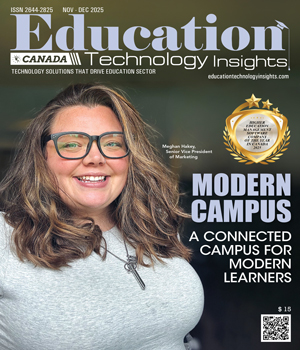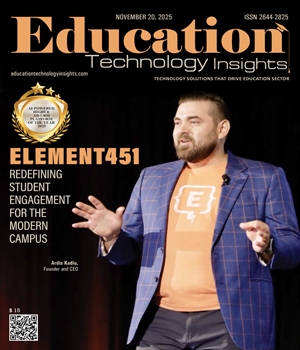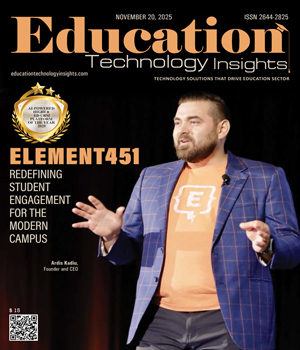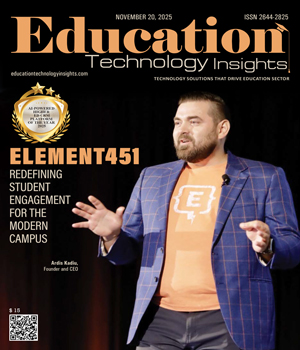THANK YOU FOR SUBSCRIBING
Be first to read the latest tech news, Industry Leader's Insights, and CIO interviews of medium and large enterprises exclusively from Education Technology Insights
Prior Learning Assessment Can Help Students Craft Their Own Academic Journey
Brian Gardner, CIO at Northampton Community College
 Brian Gardner, CIO at Northampton Community College
Brian Gardner, CIO at Northampton Community CollegeBrian Gardner is the CIO at Northampton Community College. He is an IT leader, working to evolve organizational systems as a change agent and emphasize sustainable service with clients’ perspectives and strategic vision. Throughout his professional career, Gardner has operated with higher education Information Technology (IT). He began working at a student-run college help desk and gradually moved up to the faculty support within the IT landscape. In the next few years, he broadened his span of experience from faculty support to classroom technology.
“EdTech was developing; however, the integration with mainstream educational infrastructure was at a slow as a snail pace. COVID-19 accelerated it, and barriers between learning and doing broke.”
In 2013, Gardner joined the Columbia Business School. There, he worked as director of educational technologies for eight years and stepped down from the institution as an Executive Director of Technology Services and Support. During this period, Gardner caught a distinct view on educational technology, administrative technology, and collective work processes in educational institutions. Learning from these experiences, Gardner contributes to his current roles as strategic leadership in planning, developing, implementing, and maintaining technology and information systems that support the academic and administrative goals of the College. His other responsibilities include leading campus technology, developing and managing a five-year technology budget, and IT staff.
How has the education technology landscape evolved over the years?
Education technology (EdTech) has had a significant shift. It has moved from being strictly a value add to being a core part of the academic experience. It is now a cornerstone foundational piece of teaching and learning. With the emergence of COVID-19 within the past couple of years, EdTech witnessed massive technological advancements and integration with traditional educational processes, as it has become the only option to foster remote learning.
For example, today, we are seeing students using VR technologies in automotive shop classes and chemistry labs. During the pandemic time, we have co-taught classes across London, New York, and Hong Kong using the virtues of technology and remote learning. And, advancements in EdTech helped us foster the students' learning experience and provide minimum hurdles to the teachers while teaching from across three versatile locations.
One of the things Northampton University and other colleges are collectivelyworking on is prior learning assessments. We are collecting students' existing experiences and onboarding them into our systems. This will help the students integrate their learning journey with the institution's academics and craft their future learning following their career goals.
What are the advantages of the current technological evolution in this EdTech marketplace?
In terms of advantages, educational technology has helped to enable multidisciplinary work. As a result, all kinds of silos are broken, and most interestingly, parings have been formed between different academic departments, contributing to a more collective educational experience.
In the last couple of years, Ed Tech was developing already. But COVID really accelerated it by breaking down the barriers between learning and doing. At Northampton University, we had students who hesitated to dedicate their four years to the academic experience and yet wanted to get the credentials. So EdTech helps meet the students where they are. It helped incorporate the learning experience into their existing lives, whether it's prior learning assessment or the need to learn and work simultaneously, but have those experiences not be separated from each other and have them really benefit from each other.
Did the COVID-19 pandemic bring any new pain points or challenges to the Education Technology landscape?
The challenges are not new; however, COVID-19 did highlight some of the existing latent challenges. The primary pain point that comes to my mind is the "digital divide." Even now, several students do not have sufficient internet services. And, the issueis exacerbating due to lack of internet services, as the pandemic mandated remote learning at the majority of institutions.
Another challenge that has become a concern for various educational institutions is providing blended or hybrid learning. The pandemic has divided students’ preferences on attending classes, where some desperately want to be in a classroom. At the same time, there is a major population willing to gather synchronous learning experiences using their smartphone or Chromebook. Consequently, the need for a mixed modality while teaching the students simultaneously at their own places and classrooms has risen. The challenge arises, as we will have to simultaneously provide a complete learning experience to these students per the institution’s culture and maintain the teaching standards of faculties intact.
Can you provide an overview of a recent technological development project in the EdTech space that you have been working on?
At the University of Northampton, we are precisely focused on refining our student information systems. We aim to deliver students' data to their success advisors more readily so that we can provide just-in-time help to the student at this crucial hour of a pandemic.
Another aspect of the student information system that we are focusing on is blending in our existing systems. We are working towards bringing in in-person, online, blended, and hybrid learning under one roof. By doing so, we will provide students with a learning experience where they can curate their academic journey and navigate their personal lives simultaneously. Furthermore, this will help students avoid the complexities of accessing multiple applications within the university’s interface and commence their academic needs from a single system.
Mentioned so, our development has not yet reached the desired outcomes. Therefore, we are focusing on the upcoming couple of years, where we will try to blend the university's academic, career, and community systems together and provide a one-stop mobile application handy to students.
How do you envision the future of the education space with all these potential disruptions and transformations are happening?
One of the things that I am looking at is Artificial Intelligence (AI). When it comes to natural language processing, most schools do not have the ability to translate their course content into different languages. Integration of AI will help educational institutions to provide their education contents as per the native languages of students and foster a better learning experience. Another important development will be the Last-Mile infrastructure. Utilizing it, we will be able to diminish the digital divide and provide students with internet connections to learn using the existing technologies like video conferencing and blended presence.
Self-paced learning and quantum computing will be the next evolution of the flipped classroom. Moreover, five years down the line, EdTech will have micro-credentialing, portable credentialing, and the ability to stack in students remotely, incorporated within the regular educational infrastructure. We are looking forward to having automation in educational enterprise infrastructure, which can scale up with the increase in the number of students. Features like a self-service environment will be witnessed to enhance students’ learning experience and provide them universal access to the systems.
Why is there enough for the upcoming professionals in the EdTech field, and how can they be successful?
Self-realization is necessary for both veterans and budding entrepreneurs, and everyone must be aware of their roles and the value they provide in the EdTech field. As the industry is at rapid growth, we have organizations entering the EdTech field without a clear understanding of their core business propositions and industry needs. When they try to coincide with an ongoing profitable trend, they eventually end up being a failure.
Within the entrepreneurial space in the EdTech sector, various companies are opting for incremental moves. But if any organization has accurate knowledge of the industry and its own potential. And, opts to bring in a new mechanism or a new method to impact faculty, staff, and students, that excites me. However, to succeed as an IT professional, one needs to understand the student and faculty's journey in the educational space and reflect on their own calibers to bring in innovations and reforms. Parallelly with technical skills, the companies need to possess soft skills and empathy for students and faculty to add value and succeed with their services.
Read Also
Empowering Learners Practical Integration of Inquiry-Based Learning and Scaffolding in the Classroom
Unveiling the Future of Education: Exploring the Elements of a Smart Campus Ecosystem
Building Trust in the Educational Software Ecosystem
A Learning Path Curved Via Technology
Crisis as a Catalyst for Change and Transformation

I agree We use cookies on this website to enhance your user experience. By clicking any link on this page you are giving your consent for us to set cookies. More info






















